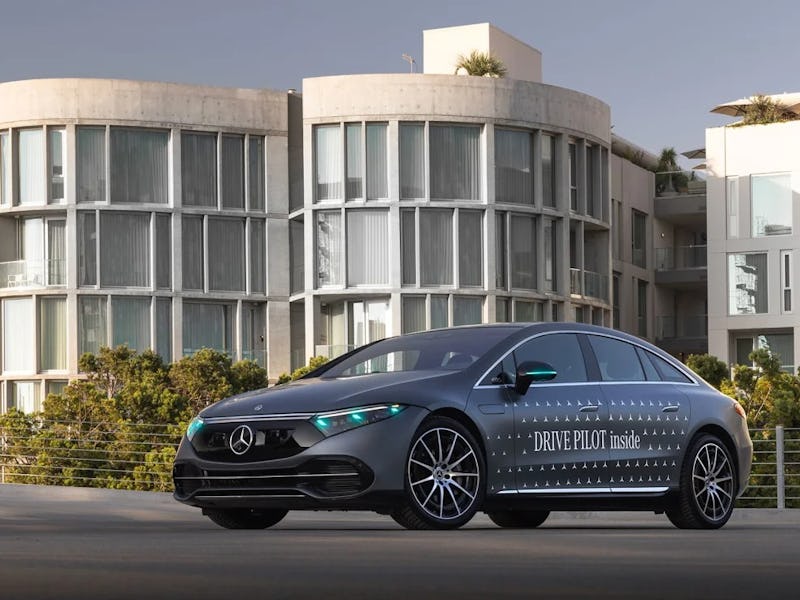Mercedes Invented a Way To Easily Identify When Cars Are Self-Driving on the Road
No more guessing if there's a human at the wheel.

Driving is a conversation. You may not process it immediately, but every time you get in the car, you’re negotiating with other cars on the road — who’s turning where, who’s merging when, and who gets to go first after stopping at a stop sign.
But what if you’re not negotiating with another driver per se? What if the car is driving itself? Well, Mercedes-Benz now has a way to communicate that, too.
Green Light, Blue Light
Recently, Mercedes received approval to marry the Holy Trinity of colored lights to its cars, adding a turquoise indicator in addition to the (red) brake lights, (white) head/tail lights, and (orange-ish) turn signals.
So far, the light has only received approval in two states — Nevada and California — but it's still a win for Mercedes and its Drive Pilot autonomous system. Notably, Drive Pilot was also the first software in a production car to be granted a level 3 classification. Even Tesla’s Autopilot and Full Self-Driving beta, for reference, are still classified as level 2.
Drive Pilot’s classification means a couple of major things — one of the biggest being that motorists who use Drive Pilot don't have to pay constant attention to the road while the software is in use. And given that freedom, it’s no wonder that Mercedes would request a way to let other drivers know when Drive Pilot is engaged.
Mercedes just got approval for a fourth colored light on its Drive Pilot-equipped self-driving vehicles.
The reasoning behind a light indicating that a car is using Drive Pilot is obvious in some ways, but not so obvious in others. For one, there are the optics — if you’re in the car and you see someone else driving without their hands on the wheel, mindlessly scrolling through their phone, it could set off alarm bells. I don’t know about you, but I don’t particularly enjoy being panicked on the road.
Alternatively, if you’re the driver in this scenario, it could get you pulled over by the cops. A noticeable light, theoretically, alleviates both of those unwanted situations.
On the less obvious end, however, a light could also — again, in theory — guide other people’s driving behavior. While autonomous systems could be safer than human driving, having a mix of the two on the road creates inherent problems. Autonomous systems, though fairly advanced now, still have a hard time predicting human driving behavior, which, as any driver knows, is a major component of moving safely from point A to point B.
If you’re driving next to a car that’s being piloted autonomously, you may want to keep an eye on its behavior or even alter your own driving as a result. A blue light might just help you do that.
Blue Light Means Go
It’s a big deal not just for the precedent — when’s the last time regulators agreed to add a light to the list of acceptable colors? — but for what it means about autonomous driving.
While Tesla has been content playing it fast and loose with its Full Self-Driving beta, both GM and Mercedes have been slower to move and have sought regulatory approval along the way. It’s hard to say what technological process is in store, but having a framework for rolling out self-driving tech, if and when it arrives, at a high level is equally important.
And for Mercedes? Well, a bunch of cars driving around with conspicuous blue lights is kind of just one big advertisement for Drive Pilot. It’s no blue bubble versus green bubble, but it’s definitely a start.